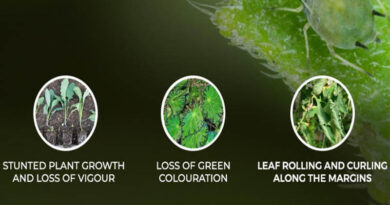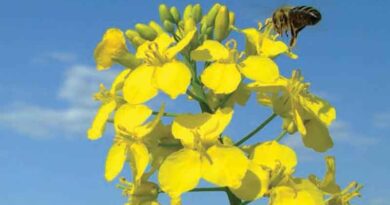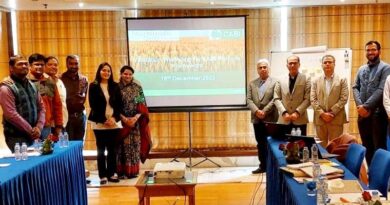Mealy Plum Aphid: An Overview
04 January 2024, Europe: The mealy plum aphid, or reed aphid, is a sap-sucking plant pest that is commercially important for fruit tree farmers. It is present across the globe and can cause significant damage in large numbers.
Introduction
Aphids are small, soft-bodied, sap-sucking bugs in the family Aphididae which cause extensive damage to plants when in large numbers. There are over 4,000 species of aphids, of which around 250 are known to be pests of crops and ornamental plant species. One of these is the mealy plum aphid (Hyalopterus pruni), a pest of stone fruit trees.
The mealy plum aphid is largely found in Europe. Particularly in Germany, Greece, Hungary, Italy, the Netherlands, Poland, Romania, Spain, Sweden, and the UK. As well as across Asia (in India, Iraq, South Korea, and Turkey), Australia, Peru, Egypt, and Morocco. This aphid was also introduced to North America in the 19th century and is now present in both Canada and the United States.
The mealy plum aphid is pale green in colour, with a white waxy covering. The wingless adults have 3 dark green stripes on their back. Whereas the winged adults have a dark thorax (the area between the neck and abdomen). They tend to be 2.5-3mm long as individuals, but the colonies cluster on the undersides of leaves and shoot tips.
Mealy plum aphid life cycle
The mealy plum aphid eggs overwinter near the bases of plant buds or in the bark of tree trunks and branches. The eggs then hatch during the spring when the young wingless aphids feed on the opening buds and leaves. In June and July, as the warm weather approaches, the winged adults develop and migrate to secondary hosts. Then, in late summer and into the autumn, the winged adults return to the primary hosts where they mate and the eggs are laid for overwintering.
The main species used as hosts by the mealy plum aphid are stone fruit species, but not all! Horseradish (Armoracia rusticana), sweet cherry (Prunus avium), apricot (Prunus armeniaca), Japanese plum (Prunus salicina), blackthorn (Prunus spinosa), and European pear (Pyrus communis) are all major hosts of this pest. Some wild species can also be host plants, including the giant reed (Arundo donax), and the common reed (Phragmites australis).
Symptoms and Damage
As the aphids feed on the trees, the trees will weaken and lose vigour. The sugar content of the fruit will also be reduced. Honeydew is a sugary liquid waste produced by aphids. It can be seen on branches and leaves and used to identify infestations. Dark sooty mould often grows on the honeydew residues, turning them black. A slight curling of the leaves can also be a key symptom to look out for. In more intense infestations, premature fruit drop, abnormal leaf fall, and stunted vegetative growth can be caused.
Mealy plum aphids have also been implicated in the spread of plum pox potyvirus, potato Y potyvirus, and millet red leaf luteovirus. Plum pox virus, or PPV, was first found in Pennsylvania, USA in 1999. It appears as chlorotic rings on the fruit and leaves of infected plants. However, symptoms vary greatly depending on a range of factors like tree species, time of year, and condition of the tree.
Management of the mealy plum aphid
Prevention can be a vital management tool. Select resistant varieties, if available. And monitor trees regularly for signs of the eggs or aphid colonies.
Biological control is the use of beneficial insects, particularly predators and parasitoids, or pathogens to control pests and diseases. Lady beetles (Hippodamia convergens) and the Asiatic lady beetle (Harmonia axyridis) are commonly used in the United States to control the mealy plum aphid. However, they are not suitable for large infestations. There are also several parasitic aphids, like Aphidius colemani, and mite species, like Exochomus nigromaculatus, which attack the mealy plum aphid.
Chemical control options include mineral oils, and pesticides with key ingredients like diazinon (WHO Class II, moderately hazardous), chlorpyrifos (WHO Class II), and esfenvalerate (WHO Class II). The eggs are not susceptible to mineral oil sprays, but the oils do affect them once hatch. Horticultural oil, canola, or garlic oil can be used. Applying mineral oils in winter can cause some young shoots to dieback. Especially in years when trees are water-stressed or have recently been subjected to freezing temperatures or dry winds. They can also be damaging to parasite populations at this time and are not as effective for aphid control.
Pesticides should generally be applied in late autumn to kill the eggs before leaf fall and the rainy season. This reduces the risk of pesticide runoff. However, if you are not treating during this period, it is important to monitor. If the threshold is then reached, e.g. more than three colonies per tree, oil can be applied in April, or other chemical pesticides can be applied in May. In spring, appropriate insecticides include diazinon and neem oil. In early to mid-October, after harvest, zinc sulphate (36%) can be applied to speed up leaf fall.
Also Read: Farmer must learn to market his produce: Vice President Dhankhar
(For Latest Agriculture News & Updates, follow Krishak Jagat on Google News)















